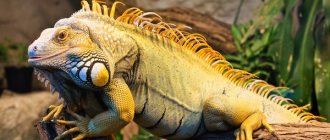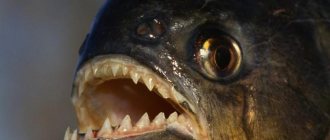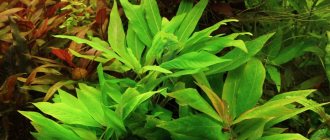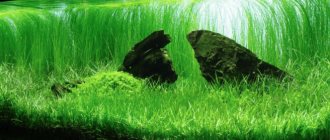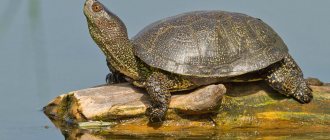Appearance
The frog has a large and flat head, on the side of which there are bulging eyes . Along with other land vertebrates, frogs have upper and lower eyelids. Under the lower eyelid of the amphibian, a nictitating membrane is found, which is called the “third eyelid”. Behind the eyes of an amphibian there is a special area covered with thin skin called the eardrum. Two nostrils with special valves are located above a huge mouth with small teeth.
The frog's front legs are characterized by the presence of four rather short toes. The hind legs of the animal are strong and well developed, equipped with five fingers, the space between which is covered with a specially leathery membrane. There are no claws on the animal's fingers. The only excretory part is located in the posterior region of the frog's body and is represented by the so-called cloacal opening. The frog's body is covered with bare skin, quite thickly lubricated with special mucus, which is abundantly secreted by the animal's numerous special subcutaneous glands.
This is interesting! The size of frogs depends on the species, so European frogs most often do not exceed one decimeter, and African goliath frogs are a kind of record holder in terms of size, therefore, with a half-meter size, they weigh several kilograms.
The size of an adult frog varies markedly depending on the species, but most often varies between 0.8-32 cm. The color of the skin is also very diverse and can be brownish, yellow, green or an unusual variegated color. Many members of the family prefer to camouflage themselves with herbaceous vegetation, foliage or branches, and therefore have characteristic green, gray and grayish-green skin.
War coloring, as a rule, indicates that the frog is poisonous, which is explained by the presence of special glands on the skin that produce substances that are toxic and harmful to human or animal health. Some frogs easily mimic, imitating dangerous amphibians to escape from enemies.
Reptile class
Reptiles are a large group of terrestrial vertebrates. These include lizards, snakes, crocodiles and turtles. During the Carboniferous period, Reptiles flourished and dominated. The planet witnessed the heyday of the era of dinosaurs, which are typical representatives of this class.
Compared to the Amphibia, this is a more progressive group. In their life cycle there is no connection with water, breathing becomes completely pulmonary. The skin is dry and covered with horny scales. One of the primitive features remains the absence of a constant body temperature.
The class Reptiles is divided into the following orders:
- detachment Beakheads;
- order Scaly;
- squad Crocodiles;
- Turtle squad.
There are no questions with representatives of the Crocodiles and Turtles groups. The Scaly group includes lizards and snakes, while the Beaked group has only one representative - the tuateria.
Varieties of frogs
There are more than 500 species of frogs in the modern world. To simplify perception, representatives of amphibians were conventionally divided into the following subfamilies:
- toad-like;
- scythe-dactyls;
- real;
- African forest;
- dwarf;
- Discopals.
The following are considered the most amazing and unusual frogs in the world:
- transparent (glass) - individuals grow up to only 2 cm, have colorless skin through which all internal organs are visible;
- Cocoy poison frogs are miniature amphibians that produce a strong toxic venom in their skin that is superior to the most dangerous snakes in the world;
- hairy - unusual amphibians in which hair grows on the back and serves as a kind of respiratory organs;
- Goliath frogs are one of the largest tailless frogs, growing up to 40 cm and weighing up to 3.5 kg;
- pointed-nosed arboreal - have an unusual nose;
- bullfrogs are large individuals that produce a deafening croaking sound;
- flying frogs - small amphibians famous for their long jumps; they are capable of jumping up to 12 meters.
Researchers claim that a large number of frog species are still unknown to humanity. Therefore, scientists are happy to continue to study the animal world in anticipation of new discoveries.
Fossil record[edit]
Very few frogfish fossils have been found. In the northern Italian formation at Monte Bolque, formed by the deposition of the Tethys Ocean in the mid-Eocene (45 million years ago), a fossil measuring 3 cm (1.2 in)
) called
Histionotophorus bassani
were originally described as frogfish, but they were later thought to belong to the closely related modern genus
Brachionichthys
or Handfish.
A 2005 fossil from Miocene Algeria (3 to 23 million years ago), Antennarius monodi
, is the first proven frogfish fossil and is believed to be most closely related to the extant Senegalese frogfish.
[14] In 2009, a new fossil from the Early Eocene Upper Ypresian discovered at Monte Bolca, Italy, was described as a new species, Eophryne barbuttii
, and is the oldest known member of this family. [15]
Why do frogs grow extra legs?
The absence of one paw from the symbol of wealth can be explained in any way (according to legend, the fourth was taken away by Buddha for sins), but individuals with extra paws have long puzzled scientists, and they have sinned on chemical waste. It turned out that amphibians become victims of chemicals that did not get into water bodies, the Ribeiroia parasites, which have a complex life cycle that begins in snails. As they grow up, they look for a new host, which becomes a fish or tadpole. And since the tadpole is in the process of growing legs, the process of reproduction of new molecules is disrupted and spreads to other parts of the body, causing the growth of new limbs. The maximum number of legs observed on a frog by humans was 10 on each side.
Taxonomy[edit]
Frogfishes belong to the order Lophiiformes, commonly known as anglerfish, which is included in the superorder Paracanthopterygii along with four other orders. They belong to the infraclass Teleostei, bony fishes classified in the class Actinopterygii. There are two subfamilies, Antennariinae and Histiophryninae, which differ in their distribution and mode of reproduction.
- Commerson's frogfish, Kona, Hawaii, Antennarius commerson
- Ocellated frogfish, Bonaire, Netherlands Antilles, A. ocellatus
- Red ocellated Clownfish, St. Kitts, F. peephole
- Frogfish, bonaire, A. multiocellatus
- Scarlet frogfish, A. coccineus
- Painted frogfish, A. pictus
- Warty frogfish, A. maculatus
Why put frogs in milk?
Many people know that in the old days it was customary to do this. It was believed that the cold amphibian prevents the heating of the product, and therefore slows down its souring. In the absence of refrigerators, this was completely justified. A similar sanitary and hygienic ritual was practiced not only in Rus', but also in many other European and Middle Eastern countries.
For a long time it was considered a superstition, but the milk really did not turn sour and biologists became interested in the phenomenon. It turned out that the skin of the amphibian has special cells capable of producing natural antibiotics, without which existence in a humid environment, especially in the tropics, would be impossible. Due to fungal and bacterial infections, for which such conditions are heaven on earth, amphibians would not have time to look back before they would be covered with mold. Natural antibiotics also change depending on the habitat. In amphibians galloping along our native shores, they are not so strong, but the peptides produced by the skin have sufficient antimicrobial action to prevent several liters of milk from souring.
Comparative characteristics of representatives
Amphibians and Reptiles have both a number of common features and features that are characteristic only of one class. For ease of comparison, these features are summarized in a table.
| Signs | Class Amphibians or Amphibians | Class Reptiles or Reptiles |
| 1. Skin | Smooth and covered in mucus | Dry, covered with horny scales |
| 2. Breathing | Mainly cutaneous, pulmonary | Pulmonary |
| 3. Availability of water in the development cycle | Eat | No |
| 4. Body temperature | No constant body temperature, cold-blooded | No constant body temperature, cold-blooded |
| 5. Habitats | Near bodies of water or shady, damp places (forest) | On land, in warm and humid places |
| 6. Fertilization | External | Internal |
You can eat, but you can't touch
One of the most powerful (and according to some sources, the most powerful) poisons of animal origin is the mucus of the tiny Colombian cocoa frog, whose weight does not exceed 1 g and height - 3 cm. But one such individual is enough to kill 1,500 people. At the same time, its poison is harmless when eaten, but the slightest amount of it that gets on a wound causes immediate paralysis and death. There is no antidote for it. By the way, the amphibian body does not know how to produce poison; it enters it with food.
The local Choco Indians, with great difficulty, obtain several specimens of cocoa in the jungle and hold them over the fire so that the poison appears on the skin, after which they smear their arrows with it. When dried, it retains its properties for up to 15 years.
Hunting[edit]
Spotfin Clownfish awaits among the corals
Frogfish eat crustaceans, other fish, and even each other. When a potential prey is first spotted, the frogfish follows it with its eyes. Then, when it approaches within about seven body lengths, the frogfish begins to move its illicium in such a way that the esca imitates the movements of the animal it resembles. As prey approaches, the frogfish moves slowly, preparing to attack; sometimes this involves approaching or "chasing" the prey, and sometimes simply changing the angle of its mouth. The trick itself is carried out due to the sudden opening of the jaws, which increases the volume of the oral cavity up to 12 times, pulling the prey into the mouth along with water. [8] The attack can last up to 6 milliseconds. [11] Water flows out through the gills, while the prey is swallowed, and the esophagus is closed by a special muscle, preventing the prey from escaping. In addition to expanding its mouth, the frogfish can also expand its stomach to swallow animals twice their size. [8]
Slow motion footage showed the frogfish inhaling its prey in just six milliseconds - so fast that other animals couldn't see it. [8]
Range, habitats
Vertebrates have become widespread in almost all countries and continents, and are also found even in arctic snow conditions. But frogs give preference precisely to tropical forest zones, where there is simply a huge variety of species and subspecies of such amphibians. Frogs primarily inhabit fresh water bodies.
True frogs are members of the family Anura amphibians, which are almost universally distributed, with the exception of South America, southern Australia and New Zealand. Our country is inhabited mainly by the grass frog (Rana temporaria) and the pond frog (Rana esculenta).
It should be remembered that the distribution of some subspecies and species of frogs may well be limited by natural causes, including rivers, mountain ranges and deserts, as well as man-made factors represented by highways and canals.
In tropical conditions, the diversity of amphibian species is much greater than in zones characterized by cold or temperate climates. Certain species and subspecies of frogs are able to live even in salt waters or beyond the Arctic Circle .
Description of the toad
A toad is a creature that is very similar in appearance to a frog. But upon closer examination, one can identify features characteristic of Reptiles. Therefore, it is quite difficult to determine whether a toad is an amphibian or a reptile. It is necessary to consider the similarities of toads with Amphibians and Reptiles.
There are few structural features of the toad by which it can be classified as a reptile. Toads lead a land-based lifestyle. Their typical habitats are holes in the soil, basements, barns and other similar places. The skin is dry and keratinized.
Structural features of the toad, characteristic of the class Amphibians or Amphibians:
- Predominantly cutaneous breathing. Despite the presence of horny substance on the surface of the skin, toads breathe it and need hydration.
- Toads breed in water bodies. Like frogs, toads lay their eggs in puddles or well-lit ponds. Then tadpoles emerge from it.
- The hind limbs are longer than the forelimbs. They move by jumping.
Based on this, there is no doubt whether the amphibian is a toad or a reptile. In this case, some similarity with reptiles is indirect.
At first glance, frogs, toads and lizards are animals that everyone knows very well. Everyone has encountered them in their lives.
Frogs are the name given to a whole group of animals that represent the order “Tailless Amphibians.” Therefore, this term can be used in relation to various representatives of this order of animals, although many use it exclusively in relation to the “True Frogs” family.
Diet of frogs
Insectivorous frogs belong to the category of predatory animals . Such amphibians with great pleasure eat a large number of mosquitoes, as well as all kinds of butterflies and small invertebrate animals. Particularly large adult insectivorous individuals do not disdain prey that is even more impressive in size, which can be represented by some species of animal frogs and relatively small relatives of their own.
This is interesting! Frogs of many species bring great benefits to people. They actively destroy and eat many worms, bugs and insects that are harmful and dangerous to humans and plants.
Hunting for their victims is carried out by frogs using a sticky and fairly long tongue, which deftly catches midges, dragonflies, moths and other winged creatures directly in flight. Among the currently existing species and subspecies of frogs, omnivorous amphibians are also known, which happily use fruits or berries for food.
Natural enemies
Natural enemies of frogs include leeches, larvae of swimming beetles and dragonflies, as well as predatory fish, including pike perch, perch, bream, pike and catfish. Frogs are also actively hunted by some species of reptiles, including grass snakes and vipers. Amphibians very often become easy prey for adult storks and herons, crows and waterfowl, some mammals, which include muskrats, rats and muskrats, shrews and representatives of mustelids.
Return to content
Character and lifestyle
Frogs are able to move perfectly on land, as well as make huge jumps, climb the crowns of tall trees and dig underground holes. Some species are characterized by the ability not only to swim perfectly, but also to run, walk, quickly climb trees, and even easily glide from a height.
One of the very interesting features of frogs is the absorption of oxygen through the skin. This process is quite successfully carried out on land or in water, due to which the animal belongs to the category of amphibians. However, European grass frogs, which are very widely known in our country, approach water bodies only during the period of active reproduction.
This is interesting! The activity levels of different species and subspecies are very different, so some of these amphibians prefer to hunt exclusively at night, but there are bright representatives who remain tireless twenty-four hours a day.
An interesting fact is that frogs need lungs in order to make rather loud and peculiar sounds called croaking . Sound bubbles and resonators help the amphibian produce the widest range of sounds, which is most often used to attract the opposite sex during the breeding season.
Periodically, adult frogs shed their skin, which is not an organ necessary for the life of an amphibian animal, and then eat it in anticipation of the growth of new skin. According to their lifestyle, all true frogs are sedentary loners, prone to short-term migration over short distances only during the breeding season. Species that live in temperate zones hibernate with the onset of winter.
Sexual dimorphism
Permanent and seasonal sexual dimorphism is a characteristic characteristic of many amphibians, including some species of frogs. Some poison dart frogs are characterized by enlargement of the finger pads of males, which is used by the amphibians when tapping on the ground and helps to actively attract females. Males of some species are distinguished by greatly enlarged eardrums. Seasonal dimorphism is caused by the presence of so-called gonadotropic hormones in the animal’s body.
This is interesting! There are species in which, upon visual inspection, it is impossible to determine their gender in accordance with only one characteristic, so it is necessary to compare several morphological characteristics at once.
One of the most striking and pronounced sexual characteristics that are characteristic of male frogs is the formation of nuptial pads as a response to changes in the hormonal levels of the testes.
In the frog, such pads are formed on the lower part of the forelimbs, on the fingers and near the mouth, due to which all mature males remain in a mated state with the female even when there is strong movement of water or attack by other animals.
Population and species status
Research shows a significant decline in the total number of frogs . More than a third of all known species are currently under threat of extinction. The causes of this plight are most often habitat destruction, noticeable climate change and alien predators.
Particularly destructive and dangerous for the frog population are infectious diseases represented by chytridiomycosis and ranavirus. Among other things, amphibians in general and some frogs in particular have an increased sensitivity to severe environmental pollution, which is due to too permeable skin and the characteristics of their life cycle.
Other interesting facts about frogs
- On the banks of the Amazon there is a species in which males give birth 10 times more often than females. Therefore, during the mating season they do not have to choose, and they try to fertilize not only living but also dead females. In scientific language, this phenomenon is called “functional necrophilia.”
- There is a variety in which the young do not grow with age, but decrease in size. While the tadpole's parents do not exceed 6 cm in length, the tadpole itself can be up to 25 cm tall.
- The transformation from egg to adult has about 30 stages, allowing it to fully adapt to life in different environments.
- Frogs perceive changes in lighting and background not with their eyes, but with their skin. Some varieties are able to adapt their color to these factors.
- When an enemy approaches, different types of amphibians behave differently. For example, the lichen copepod (moss frog) curls up into a ball and camouflages itself. But this is not how the 13-centimeter shield-back meets the enemy. She stretches her legs to the sides, inflates her belly, opens her mouth and begins to scream, rushing at the enemy.
- The African hairy frog is not actually hairy, but grows strips of skin during the mating season (males). But the most surprising thing is the fact that, being born without claws, they easily make them themselves. To do this, they simply break their fingers and pierce the skin with bone fragments. Now they are well armed! Unfortunately, not from the local Cameroonians, who love to eat them fried, which is considered a delicacy in these parts.
- The purple frog, despite its very blurry forms, digs holes well and quickly goes to a depth of 3 m or more. There she finds the moisture she needs. At the same time, representatives of the species are very unimportant parents. Having laid eggs, the female goes underground again, not caring at all what will happen to the offspring. However, like my father.
- A slightly different picture is observed in pairs of Darwin's frogs. The female behaves similarly, but the father remains near the clutch until tadpoles emerge from the eggs. Having licked them with his tongue, he transfers them all to his own throat sac, where he bears them at the expense of his own resources until they are fully formed.
- In different environments, the amphibian hears with different organs - the cells and bones of the inner ear, as well as the bones and muscles of the limbs through soil vibrations.
- Frogs have teeth, but toads, unlike them, do not. However, they only need teeth to lock prey in their mouth until their eyeballs push it inside.
- Tree frogs have special webbed feet that help them fly. This can be called a flight, of course, conditionally, but they can glide over considerable distances.
- Of the 5 thousand amphibians described by biologists, 88% are frogs.
- They were used in 11% of the revolutionary works of Nobel laureates in the fields of medicine and biology.
- A well-known folk recipe for sore throat says that you need to catch a very large toad, bring it to your mouth and actively breathe on it. According to legends, the animal will soon die, and the patient will recover. How true this recipe is is unknown, but it has been around for centuries.
COMMON FROOM: CONTENT IN A TERRARIUM, FEEDING, PHOTO, VIDEO.
ZHERLYANKA: DESCRIPTION, CONTENTS, WINTERING, PHOTO, VIDEO.
FROG HYMENOCHIRUS IN THE AQUARIUM - DESCRIPTION, REPRODUCTION, CONTENTS, PHOTO, VIDEO
Description of the class Amphibians
Amphibians are very primitive land animals. The class name reflects the main distinguishing feature of the Amphibian class. In their development cycle they necessarily have a stage of living in water. Adult animals spend almost all their time on land, but reproduction and development of larvae is possible only in water.
Therefore, every spring frogs lay their eggs in puddles and ponds, where tadpoles will subsequently grow. The skin of Amphibians is covered with mucus and is always moist. This plays a vital role, since respiration in this group of animals largely occurs through the skin. Only 30% of the oxygen absorbed comes from the lungs.
The Amphibian class is divided into 3 divisions:
- detachment Tailless;
- detachment Tailed;
- Legless squad.
By the name of the squad you can judge which part of the body is missing from each group. A representative of the Legless Ones is an interesting creature that resembles a snake - a worm. Newts belong to the order Caudates. Well, frogs occupy an honorable place among tailless amphibians. They can also include toads.
Tadpoles are the larvae of amphibians. They are very different from adult animals, both externally and internally. Initially, tadpoles have no limbs. They use their tail to move. Breathing is exclusively through gills, since they do not go onto land. They feed mainly on algae.
As the tadpole grows, metamorphoses begin to occur in the body. First of all, the limbs begin to form. The back ones grow first, then the front ones.

